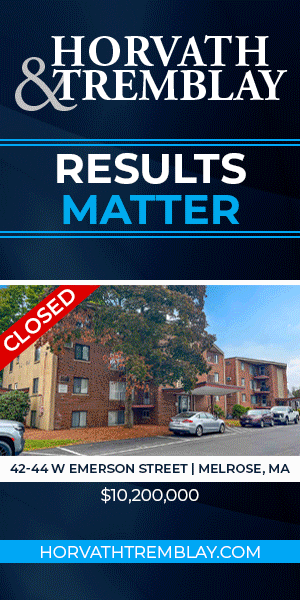Pandemic Provides Fast Track for CRE Emerging Trends: Boston Leads Nationally in Cities Recovering
October 01, 2021 - By Mike Hoban
BOSTON — No doubt there is an upheaval being felt across the various market segments of commercial real estate in the wake of the pandemic, however, many of those transformations were underway well before COVID sent the world economy into a tailspin. Trends such as companies shifting to distributed work environments (combining remote and in-office options), migration to the suburbs by millennials, an increase in online shopping, and a movement away from the open office concept were taking place long before the pandemic struck.
An examination of those trends as well as future developments in the industry was the subject of the recent CREW Boston program, “Industry Update: How the Pandemic has Accelerated Shifts in all Market Segments” at the Hyatt Regency Boston, presented by Julia Georgules, Senior Director of Research at JLL.
“A lot of the trends that we’re seeing were building up gradually but have accelerated over the past 18 months,” said Georgules, who oversees JLL’s research platform across the Eastern United States and Canada. “And a lot of the trends that we were talking about pre-COVID will be moving us forward into the next decade.”
Georgules began by re-iterating the enormity of the catastrophic turn of events, reminding the gathering that within weeks of widespread outbreaks, the Greater Boston unemployment rate skyrocketed from 2.7% to 18.1%. “It was the most severe shock to our economy – ever. But we’re on the road to recovery. And when you compare the Boston recovery to other metro areas in terms of how we’re recovering…we’re actually (doing well). I think it’s a testament not only to our unique labor market and our diversification of industries but our ability to innovate.”
That recovery has not been reflected by employees returning to the office due to the emergence of the Delta variant, but there are many encouraging signs, including the drop in the unemployment rate, which is currently hovering just below the five percent mark. Since December 2020, Massachusetts has gained 146,400 jobs through August, according to the Bureau of Labor Statistics.
One marker of a return to a degree of normalcy is the increased ridership on public transportation (as well as, unfortunately, increased traffic congestion). Georgules shared her personal experience as a daily rider of the commuter rail, noting that South Station is transforming from an empty cavern in 2020 into a far more vibrant space. “I’m happy to report that ridership has steadily improved, and we expect there to be continued demand for transit-oriented development in the future,” she stated.
While office, hotel, and retail “face continued headwinds,” specialty sectors like life sciences, data centers, and single-family rentals are flourishing. Office continues to see very low in-person occupancy rates as the anticipated post Labor Day return to work was derailed by the Delta variant, and many large corporate users like Apple and Wells Fargo continue to push out their return to corporate offices. But Georgules countered that JLL’s research indicates that there is still a desire on the part of employees to return to the office – to see colleagues, to innovate, and to collaborate in person. “What we have found is that companies that are bringing people back are calling their office spaces “collaboration” or “gathering” centers, and are increasingly looking for unique locations to bring employees back to. Differentiated products will continue to drive demand, and we’ll continue to see tenants gravitating toward higher-quality space.” She added that building owners have taken advantage of the downtime during COVID to upgrade their buildings, with an increased focus on bolstering amenities as a way for employers to incentivize employees to return.
ESG (Environmental, Social and Governance) is also becoming a significant driver in real estate leasing, investment, and CAPEX decisions, and devising ways to mitigate the effects of climate change in the built environment is being explored in earnest. “What we’re seeing now is a lot of companies creating net-zero goals – even real estate companies – which aligns nicely with major corporate occupiers who are saying, ‘we can use our real estate to impact the environment positively,” said Georgules. “And we’re also seeing real estate developers and owners implement sustainability metrics and requirements, which is an interesting shift – not only in supporting the goals of tenants but also creating mechanisms for tenants to be able to reach their net-zero goals.”
It’s no secret that with the shift to online shopping for many consumers, e-commerce has dramatically pumped up leasing and investment sales demand for industrial product. With rental rates nationally and locally reaching record highs, industrial is the new darling of commercial real estate investors. Pre-pandemic, grocery shopping was one segment of e-commerce that had lagged behind online shopping in general, but it accelerated dramatically due to health concerns around in-person grocery shopping during the pandemic. “All of a sudden, you saw the grocery sector go into high demand,” said Georgules, “which led to product shortages and inflated pricing, and which in turn has spurred conversation around the benefits of re-shoring manufacturing, including the life science sector.”
Industrial demand is strongest in dense population centers, and Boston continues to see population growth. JLL research indicates that the market currently does not have enough supply to meet these changing consumer behaviors, and the question remains whether Boston will be able to meet the increased industrial demand anticipated in the next five years.
The retail picture (which includes restaurants) remains cloudy as the sector continues to feel the effects of the pandemic on consumer behavior. “What we’ve experienced over the past 12 months is that the residential-driven retail experience has been an inhibitor of recovery.” So while foot traffic for the destination retail (and restaurants) of the Seaport has rebounded fairly well (down just 11.9 percent from pre-pandemic levels), the residential-driven retail of Downtown Crossing has not (down 46.4%).
The picture for multifamily housing in the cities is considerably brighter. Despite the early pandemic panic that cities would become ghost towns (as they did in the initial stages of the pandemic in cities like New York), “reports of their demise were premature.” While urban multifamily housing saw the quickest drops in effective rents, they are now recovering at the fastest rate (See Real Reporter story: Greater Boston Apartments Back). “All of the crisis mode thinking (regarding rents not coming back) that we applied at the beginning of the pandemic are not coming true – which is a positive,” she said.
Life Sciences will continue to be a significant growth driver for the region, although there is a question as to whether startups will continue to come here or go to other emerging markets.
And for those concerned that with the soaring level of new development and office-to-lab conversions underway in the Boston market, Georgules points out that relative to other sectors, life science is just a small fraction of the built environment. For perspective, the national inventory for industrial is 13.6 billion square feet, office 4.3 billion, medical office 1.5 billion, while life science is a comparatively minuscule 147 million square feet – smaller than the Boston metro office inventory.
Nationally, the life science market is “significantly undersupplied” and Georgules believes that Boston has the opportunity to continue to capture that demand. “In fact, Boston has the largest lab development pipeline, which will continue to enable life sciences growth – far above any of the peer life science markets (San Francisco, San Diego). So Boston is not overbuilding – it is actually undersupplied.”
Following the program, CREW Boston president Kerry Hawkins, Senior Director for Capital Markets with JLL, remarked that it was “really interesting to note from Julia’s presentation that Boston is the Gateway city closest to recovery. This speaks volumes about our talented labor pool and diverse economy, ripe with many high-touch industries including life science, healthcare, education, and technology. “
 Julia Georgules
Julia Georgules
 601 Congress St. Boston MA
601 Congress St. Boston MA
 DraftKings Office 222 Berkeley St., Boston MA
DraftKings Office 222 Berkeley St., Boston MA





